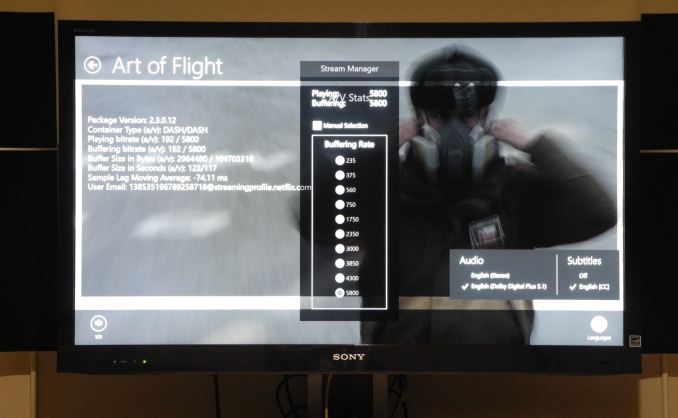The NVIDIA GeForce GTX 750 Ti and GTX 750 Review: Maxwell Makes Its Move
by Ryan Smith & Ganesh T S on February 18, 2014 9:00 AM ESTHTPC Aspects : Network Streaming Performance
Windows 7-based HTPCs need hardware acceleration in both Adobe Flash and Microsoft Silverlight for optimal streaming performance with YouTube and Netflix. The move to Windows 8.1 has made Silverlight unnecessary. The Netflix app on Windows 8.x brings a HTPC's capability on par with dedicated streaming consoles, with support for Super HD (6 Mbps) streams as well as Dolby Digital Plus bitstreaming support. The latest app also renders the video in such a way as to make taking screenshots an exercise in frustration.
As the above photograph shows, the Netflix app can be set to bitstream Dolby Digital Plus to the AV receiver and the 750Ti supports it. The video and audio streams are at 5.8 Mbps and 192 kbps respectively. It is not immediately evident as to whether GPU acceleration is being utilized. However, tracking the GPU / VPU loading and PC power consumption numbers make it obvious that it is not software decode at work in the Netflix app.
Unlike Silverlight, Adobe Flash continues to maintain some relevance right now. YouTube continues to use Adobe Flash to serve FLV (at SD resolutions) and MP4 (at both SD and HD resolutions) streams. YouTube's debug OSD indicates whether hardware acceleration is being used or not.
Similar to our Netflix streaming test, we recorded GPU / VPU loading as well as power consumption at the wall when streaming the 1080p version of the sample YouTube clip. The table below presents the relevant numbers for various configurations and streaming services.
| Streaming Video Performance | ||||||
| Netflix | YouTube | |||||
| GPU/VPU Load | Power | GPU/VPU Load | Power | |||
| NVIDIA GeForce GTX 750 Ti | 11.95/12.65% | 56.44 W | 16.26/15.74% | 55.45 W | ||
| NVIDIA GeForce GT 640 | 5.99/25.80% | 58.89 W | 15.57/25.72% | 58.93 W | ||
| AMD Radeon HD 7750 | 0.72% | 66.79 W | 3.57% | 67.11 W | ||
NVIDIA has been touting Maxwell's low power nature, and it proves to be the best of the three candidates in terms of power efficiency when it comes to GPU support for streaming services.












177 Comments
View All Comments
dylan522p - Tuesday, February 18, 2014 - link
They are waiting for 20nm for the entire 800 series .MugatoPdub - Tuesday, February 18, 2014 - link
Interestingly, it seems Nvidia has simply followed Intel in the "mobile first" market race, it is starting to feel as if the enthusiast will be left in the dust within the next few years =(Krysto - Tuesday, February 18, 2014 - link
Not likely, thanks to the boom in VR that we'll be seeing, which at 4k and 120fps games, will require 16x the performance we get now for games, just to play the same games, in a few years.So if anything, Nvidia should be making GPU's at the high-end that are a level or two ABOVE Titan (think 20-30 TF GPUs in 2015).
A5 - Tuesday, February 18, 2014 - link
They probably will? I'm guessing we won't see stuff below the top end (or SLI) targeted at 4K until late 2015/spring 2016, though.madmilk - Tuesday, February 18, 2014 - link
I doubt enthusiasts will be left behind, simply because HPC users will demand a 225W Tesla card. That in turn can easily sold as a 250W enthusiast card, perhaps under the Titan line.Mondozai - Wednesday, February 19, 2014 - link
Also, Nvidias desktop business is contributing to their profits and is seeing revenue growth. Their Tegra business revenue is falling almost 50% year over year.The desktop high-end GPU market will grow in good health for years to come. Their discrete laptop GPUs, however, will face doom in a relativeley short period of time as integrated GPUs performance rises to a level when most people are satisfied. Laptops specifically for gaming continues to be an unsignificant market.
jkauff - Tuesday, February 18, 2014 - link
madVR NNEDI3 uses OpenCL, and works fine on Intel and AMD boards. NVIDIA OpenCL support has been broken for the last couple of driver iterations. Please use your influence with the NVIDIA developers to get this fixed in the next driver release.IKeelU - Tuesday, February 18, 2014 - link
ugh, cryptocointexasti89 - Tuesday, February 18, 2014 - link
Wow! .. Substantially faster than 260x and consuming less than 60w using same process node. Really impressive. I can't wait to see how Maxwell arch performance & power scale at 20nm. I'm really convinced now that AMD GCN is not as efficient as many reviewers think. AMD will very likely have a hard time in this round.g101 - Tuesday, February 18, 2014 - link
*slower...Almost always slower than the 260x.... , all for power savings in the range of 5-10%...How...exciting?You should try reading the actual words that have been written in the article.